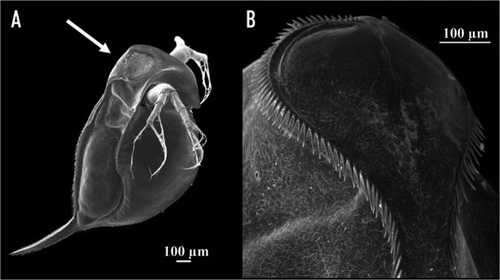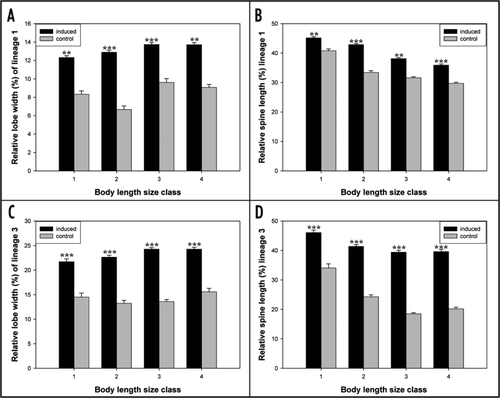Abstract
DNA barcoding has emerged as valuable tool to document global biodiversity. Mitochondrial cytochrome oxidase I (COI) sequences serve as genetic markers to catalog species richness in the animal kingdom and to identify cryptic and polymorphic animal species. Furthermore, DNA barcoding data serve as a fuel for ecological studies, as they provide the opportunity to unravel species interactions among hosts and parasites, predators and prey, and among competitors in unprecedented detail. In a recent paper we described how DNA barcoding in combination with morphological and ecological data unraveled a striking predator-prey interaction of organisms from temporary aquatic habitats, the predatory notostracan Triops and its prey, cladocerans of the Daphnia atkinsoni complex.
The Barcode of Life initiative attempts to inventory species richness on earth. Short DNA sequences such as the plastid trnH-psbA intergenic spacerCitation1 or the plastid matK geneCitation2 in flowering plants, and the cytochrome c oxidase subunit I (COI) in metazoansCitation3–Citation5 have recently been applied as molecular markers for sequence-based species identification. For the animal kingdom, genetic data (COI barcodes), as well as morphological, geographical and other relevant information are assembled in a large-scale public taxonomic library.Citation6 The DNA barcoding approach has proven to be useful in various ways; for example, it provides the opportunity to discover crypticCitation3 or alienCitation7 species, to catalogue ancient taxaCitation8 or to identify unknown developmental stages.Citation9,Citation10 Although such single-locus approaches have a number of limitations,Citation11–Citation13 barcoding was successfully used to unravel several basic questions related to biodiversity, systematics and taxonomy.Citation14 Furthermore, barcoding projects inspired a number of novel ecological and evolutionary approaches, such as community phylogenetics or ecological genomics.Citation15 In a recent paperCitation16 we demonstrated how a study integrating genetic data from an ongoing barcoding campaign with information on ecology and morphology of the studied animal species revealed the function of an inducible morphological structure in a cryptic Daphnia species complex. We discovered that two lineages of the D. atkinsoni complex changed substantially their morphology in response to infochemicals (kairomones) released by the tadpole shrimp Triops cancriformis. Mature daphnids developed longer tail spine and formed a distinct morphological structure, the so-called “crown of thorns”. This “crown”, a dorsal extension of the carapace, consists of a heavily spined cuticular shield at both sides of the head (). Our predation experiments subsequently proved the protective effect of those traits.
Our barcoding results per se were relevant for Daphnia taxonomy. On the one hand, we discovered yet unknown cryptic lineages within Western Palaeartic populations of the D. atkinsoni complex. On the other hand, we showed a discrepancy between molecular data and putative species-specific morphological characters, which questioned the validity of a previously recognized taxon. Such results were in accordance with other studies which emphasized the usefulness of the barcoding approach for identification and diversity assessment in other important zooplankton groups.Citation17,Citation18 Analysis of the barcoding data was therefore the first critical step stimulating the experimental work elucidating some aspects of the Daphnia-Triops interactions in temporary waters.
In addition to previously published results,Citation16 we show here that both lineages of the Daphnia atkinsoni species complex, which we tested in our experiments, respond to Triops cancriformis during their entire life cycle. We exposed the daphnids to the predator as previously described,Citation16 and measured traits affected by the kairomone in four different size cohorts according to their developmental stage. Both traits, the “crown of thorns” and the tail spine, were significantly pronounced in the animals exposed to predator kairomone compared to the control animals in all body-length size classes (, nested ANOVA, all p < 0.02). As the prey species (Daphnia) as well as the predator reproduce in the habitat, various size-classes of both species may occur simultaneously. Hence, daphnids of different developmental stages, ranging from neonates to large adult individuals, are under predation by Triops. It is therefore likely that the same defensive mechanisms are effective in both juvenile and adult prey animals. The spikes of the “crown of thorns” and of the tail spine, possibly in combination with a stronger cuticular armor,Citation19 may interfere with the feeding apparatus of the omnivorous notostracan and thus may explain the protective effect of induced traits. However, as in a number of other Daphnia species which show inducible morphological defences,Citation20 the exact defensive mechanism of the “crown” still remains unknown.
The discovery of the inducibility of the daphnid “crown of thorns”, and experimental proof of its protective mechanism,Citation16 demonstrates the potential role of the DNA barcoding approach as an essential asset of integrative studiesCitation10,Citation21 to reveal mechanisms with an impact transcending the borders of taxonomy and species identification. To reach such a goal, a balance between cataloguing biodiversity and careful analyses of the resulting patterns must be established. Molecular barcodes not only have proven to represent a helpful tool for taxonomy, but they are also bound to become an inspiring source of information for ecologists or evolutionary biologists.
Figures and Tables
Figure 1 (A) Daphnia atkinsoni sensu stricto (lineage 3; whole body SEM image) shows in the presence of notostracans a distinctly enlarged carapace extension into the head shield lined by spines, forming the “crown of thorns” (indicated by arrow). (B) Dorsal view on the “crown” (SEM image).

Figure 2 Predator cue induction experiments. Mean relative (%) lobe width (A and C) and tail spine length (B and D) in four different body length size classes (1: below 700 µm; 2: 701 to 1,200 µm; 3: 1,201 to 2,000 µm; 4: over 2,000 µm) of two clones representing different lineages of the D. atkinsoni complex (lineage 1, lineage 3) raised with (induction) and without (control) chemical cues released from Triops cancriformis. Asterisks indicate significant differences (nested ANOVA, ***p < 0.001; **p < 0.02), error bars indicate standard error of the mean.

Addendum to:
References
- Kress WJ, Wurdack KJ, Zimmer EA, Weigt LA, Janzen DH. Use of DNA barcodes to identify flowering plants. Proc Natl Acad Sci USA 2005; 102:8369 - 8374
- Lahaye R, Van der Bank M, Bogarin D, Warner J, Pupulin F, Gigot G, et al. DNA barcoding the floras of biodiversity hotspots. Proc Natl Acad Sci USA 2008; 105:2923 - 2928
- Hebert PDN, Ratnasingham S, deWaard JR. Barcoding animal life: cytochrome c oxidase subunit 1 divergences among closely related species. Proc Roy Soc Lond B Bio 2003; 270:96 - 99
- Ward RD, Zemlak TS, Innes BH, Last PR, Hebert PDN. DNA barcoding Australia's fish species. Philos T Roy Soc B 2005; 360:1847 - 1857
- Smith MA, Wood DM, Janzen DH, Hallwachs W, Hebert PDN. DNA barcodes affirm that 16 species of apparently generalist tropical parasitoid flies (Diptera, Tachinidae) are not all generalists. Proc Natl Acad Sci USA 2007; 104:4967 - 4972
- Ratnasingham S, Hebert PDN. BOLD: The Barcode of Life Data System (www.barcodinglife.org). Mol Ecol Notes 2007; 7:355 - 364
- Armstrong KF, Ball SL. DNA barcodes for biosecurity: invasive species identification. Philos T Roy Soc B 2005; 360:1813 - 1823
- Lambert DM, Baker A, Huynen L, Haddrath O, Hebert PDN, Millar CD. Is a large-scale DNA-based inventory of ancient life possible?. J Hered 2005; 96:279 - 284
- Greenstone MH, Rowley DL, Heimbach U, Lundgren JG, Pfannenstiel RS, Rehner SA. Barcoding generalist predators by polymerase chain reaction: carabids and spiders. Mol Ecol 2005; 14:3247 - 3266
- Pfenninger M, Nowak C, Kley C, Steinke D, Streit B. Utility of DNA taxonomy and barcoding for the inference of larval community structure in morphologically cryptic Chironomus (Diptera) species. Mol Ecol 2007; 16:1957 - 1968
- Moritz C, Cicero C. DNA barcoding: Promise and pitfalls. PLoS Biol 2004; 2:1529 - 1531
- Will KW, Mishler BD, Wheeler QD. The perils of DNA barcoding and the need for integrative taxonomy. Syst Biol 2005; 54:844 - 851
- Trewick SA. DNA Barcoding is not enough: mismatch of taxonomy and genealogy in New Zealand grasshoppers (Orthoptera: Acrididae). Cladistics 2008; 24:240 - 254
- Miller SE. DNA barcoding and the renaissance of taxonomy. Proc Natl Acad Sci USA 2007; 104:4775 - 4776
- Kress WJ, Erickson DL. DNA barcodes: Genes, genomics and bioinformatics. Proc Natl Acad Sci USA 2008; 105:2761 - 2762
- Petrusek A, Tollrian R, Schwenk K, Haas A, Laforsch C. A “crown of thorns” is an inducible defense that protects Daphnia against an ancient predator. Proc Natl Acad Sci USA 2009; 106:2248 - 2252
- Bucklin A, Wiebe PH, Smolenack SB, Copley NJ, Beaudet JG, Bonner KG, et al. DNA barcodes for species identification of euphausiids (Euphausiacea, Crustacea). J Plankton Res 2007; 29:483 - 493
- Chen G, Hare MP. Cryptic ecological diversification of a planktonic estuarine copepod, Acartia tonsa. Mol Ecol 2008; 17:1451 - 1468
- Laforsch C, Ngwa W, Grill W, Tollrian R. An acoustic microscopy technique reveals hidden morphological defenses in Daphnia. Proc Natl Acad Sci USA 2004; 101:15911 - 15914
- Tollrian R, Dodson SI. Tollrian R, Harvell CD. Inducible defenses in cladocerans. The Ecology and Evolution of Inducible Defenses 1999; Princeton Princeton University Press 177 - 202
- Dupont S, Wilson K, Obst M, Skold H, Nakano H, Thorndyke MC. Marine ecological genomics: when genomics meets marine ecology. Mar Ecol-Prog Ser 2007; 332:257 - 273